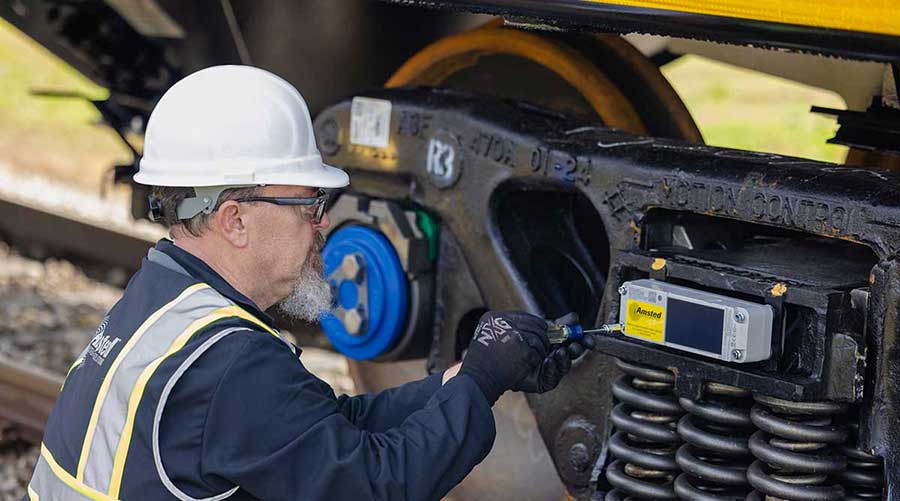Stay updated on news, articles and information for the rail industry
 railPrime
railPrime
October 2011
Rail News: Rail Industry Trends
Opening the communication floodgates — by Pat Foran (Context, October 2011)
— by Pat Foran, Editor
Opening the Communication Floodgates
Railroads serving the Mountain West and Great Plains have had a rough go of it in recent months as engineering, mechanical, transportation, marketing and communications execs have attempted to weather — and help customers weather — the aftermath of devastating spring and summer floods. Record snowfalls in the Rocky Mountains and near-record rainfalls in Montana triggered floods along the Missouri River, causing big-time damage to Union Pacific Railroad track in seven states, and putting the Class I's recovery practice plans to the test, as Managing Editor Jeff Stagl reports in this month's cover story.
UP officials believe their proactive plans served the railroad — and the railroad's customers — pretty well. The experience also afforded UP marketing and service reps an opportunity to improve customer communication, be it regarding possible traffic problems, rail-car needs or other service issues. A little — no, a lot — of communication went a long way: Despite the floods' impacts on service, customers rated UP a 90 out of 100 in a July satisfaction survey, UP Executive Vice President of Marketing and Sales Jack Koraleski told Stagl.
The powers that be at BNSF Railway Co., which also was hit hard by flooding, have been just as acutely aware of the need to communicate. And they're using today's tools of the communication trade to ensure messages regarding flood recovery efforts are heard — and seen.
"These floods have had a devastating effect on our service and our velocity across our network, [and] our customers understand that impact," says BNSF Executive Vice President of Operations Greg Fox in "Rising Above: The Floods of 2011," a seven-minute video posted on the Class I's website. "I can also say that we have many customers who are struggling with the duration of this impact, and they're telling us, as they should, 'You've got to restore service, you've got to restore velocity.' And that's what we owe our customers. Our challenge is to take the same energy we put into addressing the crisis now into restoring service and velocity across our network."
Chances are, the energy management plan again will include keeping the communication lines open, perhaps with a vengeance — be they online, over the phone or via any number of other messaging tools. More communication power to them.
STB: Rail Industry's Cost of Capital Rose in 2010
For those who are keeping score: Just as this issue was about to go to press, the Surface Transportation Board (STB) announced it had calculated the rail industry's after-tax cost of capital for 2010 at 11.03 percent compared with 10.43 percent for 2009.
Each year, the board calculates the industry's cost of capital, which represents the STB's estimate of the average rate of return needed to persuade investors to provide capital to the freight-rail industry. The board uses the figure when it evaluates railroad revenue adequacy. It also uses the figure when determining the reasonableness of a challenged rail rate, considering a rail line abandonment proposal or valuing a particular railroad operation. The STB estimated the cost-of-equity component of the industry's cost of capital using an average of a Capital Asset Pricing Model approach and a multi-stage Discounted Cash Flow model.
"We are pleased with the STB's decision, which affirmed that the cost of capital computations submitted by AAR conformed to their methodology," said Holly Arthur, an Association of American Railroads' (AAR) spokeswoman, in an email.
In Brief: A Railway Interchange Recap
The rail world ("world" as in from all around the globe) descended upon Minneapolis in droves last month, making the long-awaited Railway Interchange 2011 a rousing success by any number of measures, event organizers and an array of attendees told us.
Held Sept. 18-21, the event comprised the American Railway Engineering and Maintenance-of-Way Association (AREMA) Annual Technical Conference; technical presentations courtesy of the Coordinated Mechanical Associations; and an exhibition organized by the Railway Engineering-Maintenance Suppliers Association, Railway Systems Suppliers Inc. and Railway Supply Institute. In early October, AREMA officials ballparked the total at about 9,000; pre-show, organizers were projecting 7,000 or possibly 8,000. More than 600 exhibitors displayed products, equipment and systems.
For a video summation of the event, check out "Inside and out at Railway Interchange 2011," which was recorded by Managing Editor Jeff Stagl. It's posted in the "multimedia" section of our website.


 2025 MOW Spending Report: Passenger-rail programs
2025 MOW Spending Report: Passenger-rail programs
 Gardner steps down as Amtrak CEO
Gardner steps down as Amtrak CEO
 Guest comment: Oliver Wyman’s David Hunt
Guest comment: Oliver Wyman’s David Hunt
 Women of Influence in Rail eBook
Women of Influence in Rail eBook







